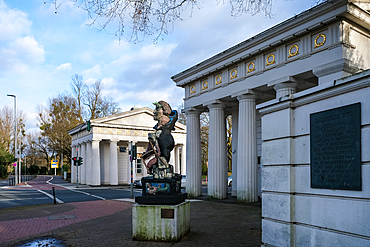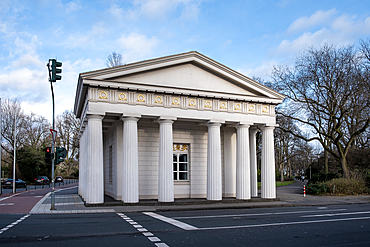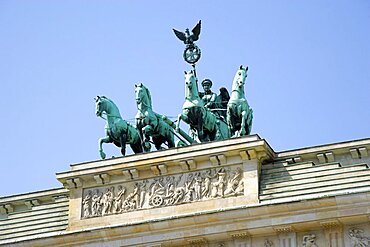Recent searches
Loading...
1373-309 - View of the Ratinger Tor, a customs gate that was built between 1811 and 1815 in the classicist style, the last built and only remaining city gate in the original city of Düsseldorf.
1373-308 - View of the Ratinger Tor, a customs gate that was built between 1811 and 1815 in the classicist style, the last built and only remaining city gate in the original city of Düsseldorf.
1373-307 - View of the Ratinger Tor, a customs gate that was built between 1811 and 1815 in the classicist style, the last built and only remaining city gate in the original city of Düsseldorf.
1242-490 - Walls and towers being the last remaining corner of the enormous abbey church built in Cluny in the 1100s, Cluny, Saone-et-Loire, Burgundy, France, Europe
1113-107175 - Exterior view of the Volgograd Panorama Museum and the Gerhardt Mill (one of the few remaining buildings from the Battle of Stalingrad in World War II), Volgograd, Volgograd District, Russia, Europe
1113-107014 - Monument outside the Gerhardt Mill (one of the few remaining buildings from the Battle of Stalingrad in World War II), Volgograd, Volgograd District, Russia, Europe
1350-2688 - Verges, a small town in the Northeast of Catalonia (Spain), during Easter celebrates the Procession of Verges with skeletons dancing on the sound of a drum, Roman soldiers, known as the 'Manages', and a representation of the life and crucifixion of Jesus Christ. The Procession features the Dance of Death, a tradition from the Middle Age associated with epidemics and plagues and the only one remaining in Spain Ten skeletons dance to the beat of a drum to remember that no one is exempt of death. The backdrop of the medieval walls and towers of Verges is key to this macabre staging.
1350-2693 - Verges, a small town in the Northeast of Catalonia (Spain), during Easter celebrates the Procession of Verges with skeletons dancing on the sound of a drum, Roman soldiers, known as the 'Manages', and a representation of the life and crucifixion of Jesus Christ. The Procession features the Dance of Death, a tradition from the Middle Age associated with epidemics and plagues and the only one remaining in Spain Ten skeletons dance to the beat of a drum to remember that no one is exempt of death. The backdrop of the medieval walls and towers of Verges is key to this macabre staging.
1350-2692 - Verges, a small town in the Northeast of Catalonia (Spain), during Easter celebrates the Procession of Verges with skeletons dancing on the sound of a drum, Roman soldiers, known as the 'Manages', and a representation of the life and crucifixion of Jesus Christ. The Procession features the Dance of Death, a tradition from the Middle Age associated with epidemics and plagues and the only one remaining in Spain Ten skeletons dance to the beat of a drum to remember that no one is exempt of death. The backdrop of the medieval walls and towers of Verges is key to this macabre staging.
1350-2695 - Verges, a small town in the Northeast of Catalonia (Spain), during Easter celebrates the Procession of Verges with skeletons dancing on the sound of a drum, Roman soldiers, known as the 'Manages', and a representation of the life and crucifixion of Jesus Christ. The Procession features the Dance of Death, a tradition from the Middle Age associated with epidemics and plagues and the only one remaining in Spain Ten skeletons dance to the beat of a drum to remember that no one is exempt of death. The backdrop of the medieval walls and towers of Verges is key to this macabre staging.
1350-2690 - Verges, a small town in the Northeast of Catalonia (Spain), during Easter celebrates the Procession of Verges with skeletons dancing on the sound of a drum, Roman soldiers, known as the 'Manages', and a representation of the life and crucifixion of Jesus Christ. The Procession features the Dance of Death, a tradition from the Middle Age associated with epidemics and plagues and the only one remaining in Spain Ten skeletons dance to the beat of a drum to remember that no one is exempt of death. The backdrop of the medieval walls and towers of Verges is key to this macabre staging.
1350-2691 - Verges, a small town in the Northeast of Catalonia (Spain), during Easter celebrates the Procession of Verges with skeletons dancing on the sound of a drum, Roman soldiers, known as the 'Manages', and a representation of the life and crucifixion of Jesus Christ. The Procession features the Dance of Death, a tradition from the Middle Age associated with epidemics and plagues and the only one remaining in Spain Ten skeletons dance to the beat of a drum to remember that no one is exempt of death. The backdrop of the medieval walls and towers of Verges is key to this macabre staging.
1350-2687 - Verges, a small town in the Northeast of Catalonia (Spain), during Easter celebrates the Procession of Verges with skeletons dancing on the sound of a drum, Roman soldiers, known as the 'Manages', and a representation of the life and crucifixion of Jesus Christ. The Procession features the Dance of Death, a tradition from the Middle Age associated with epidemics and plagues and the only one remaining in Spain Ten skeletons dance to the beat of a drum to remember that no one is exempt of death. The backdrop of the medieval walls and towers of Verges is key to this macabre staging.
1350-2689 - Verges, a small town in the Northeast of Catalonia (Spain), during Easter celebrates the Procession of Verges with skeletons dancing on the sound of a drum, Roman soldiers, known as the 'Manages', and a representation of the life and crucifixion of Jesus Christ. The Procession features the Dance of Death, a tradition from the Middle Age associated with epidemics and plagues and the only one remaining in Spain Ten skeletons dance to the beat of a drum to remember that no one is exempt of death. The backdrop of the medieval walls and towers of Verges is key to this macabre staging.
1350-2696 - Verges, a small town in the Northeast of Catalonia (Spain), during Easter celebrates the Procession of Verges with skeletons dancing on the sound of a drum, Roman soldiers, known as the 'Manages', and a representation of the life and crucifixion of Jesus Christ. The Procession features the Dance of Death, a tradition from the Middle Age associated with epidemics and plagues and the only one remaining in Spain Ten skeletons dance to the beat of a drum to remember that no one is exempt of death. The backdrop of the medieval walls and towers of Verges is key to this macabre staging.
1350-2697 - Verges, a small town in the Northeast of Catalonia (Spain), during Easter celebrates the Procession of Verges with skeletons dancing on the sound of a drum, Roman soldiers, known as the 'Manages', and a representation of the life and crucifixion of Jesus Christ. The Procession features the Dance of Death, a tradition from the Middle Age associated with epidemics and plagues and the only one remaining in Spain Ten skeletons dance to the beat of a drum to remember that no one is exempt of death. The backdrop of the medieval walls and towers of Verges is key to this macabre staging.
1350-2694 - Verges, a small town in the Northeast of Catalonia (Spain), during Easter celebrates the Procession of Verges with skeletons dancing on the sound of a drum, Roman soldiers, known as the 'Manages', and a representation of the life and crucifixion of Jesus Christ. The Procession features the Dance of Death, a tradition from the Middle Age associated with epidemics and plagues and the only one remaining in Spain Ten skeletons dance to the beat of a drum to remember that no one is exempt of death. The backdrop of the medieval walls and towers of Verges is key to this macabre staging.
832-391378 - Overhead abstract of apple pie, empty plate with remaining crumbs and fork
805-1158 - Single minaret remaining on a high plinth from Bahadur Shah's mosque built between 1526-36, Champaner, Gujarat, India, Asia
1174-4677 - Two divers swimming along the remaining structure of a shipwreck.
1287-21 - One of the few remaining large cranes on the River Clyde at Clydebank, West Dumbartonshire, Scotland, United Kingdom, Europe
450-4300 - One of the few remaining standing statues of Stalin in public, Gori, his birthplace, Central Georgia, Central Asia, Asia
749-2267 - Painting by Russian artist Dimitry Vrubel of Brezhnev kissing Honecker at the remaining section of the Berlin Wall at the East Side Gallery, Friedrichshain, Berlin, Germany, Europe
857-91842 - On a cold winter day a canoe decorated with Christmas lights floats on the last remaining open water on Lake Monona.
465-3405 - One of the last remaining Inughuit subsistence hunters, Naimanngitsoq Kristiansen, stands on watch with his rifle for marine mammals at the ice edge, Greenland, Denmark, Polar Regions
465-3406 - One of the last remaining Inughuit subsistence hunters, Naimanngitsoq Kristiansen, stands on watch with his rifle for marine mammals at the ice edge, Greenland, Denmark, Polar Regions
857-87026 - Onboard Shamrock V (JK3) during the Regates Royales in Cannes, France. Shamrock V was built in 1930 for Sir Thomas Lipton's fifth and last America's Cup challenge. Designed by Nicholson, she was the first British yacht to be built to the new J Class Rule and is the only remaining J to have been built in wood.
797-12759 - Germany, Berlin, Mitte, Brandenburg Gate or Brandenburger Tor in Pariser Platz leading to Unter den Linden and the Royal Palaces with the Quadriga of Victory on top. The only remaining of the original 18 gates in the Berlin Customs Wall.
797-12754 - Germany, Berlin, Mitte, sightseeing tourists at the Brandenburg Gate or Brandenburger Tor in Pariser Platz leading to Unter den Linden and the Royal Palaces with the Quadriga of Victory on top. The only remaining of the original 18 gates in the Berlin Customs Wall.
797-12760 - Germany, Berlin, Mitte, Brandenburg Gate or Brandenburger Tor in Pariser Platz leading to Unter den Linden and the Royal Palaces with the Quadriga of Victory on top. The only remaining of the original 18 gates in the Berlin Customs Wall.
797-12753 - Germany, Berlin, Mitte, Brandenburg Gate or Brandenburger Tor in Pariser Platz leading to Unter den Linden and the Royal Palaces with the Quadriga of Victory on top. The only remaining of the original 18 gates in the Berlin Customs Wall.
797-12793 - Germany, Berlin, Mitte, Brandenburg Gate or Brandenburger Tor in Pariser Platz illuminated at night leading to Unter den Linden and the Royal Palaces with the Quadriga of Victory on top. The only remaining of the original 18 gates in the Berlin Customs Wall.
797-12762 - Germany, Berlin, Mitte, sightseeing tourists at the Brandenburg Gate or Brandenburger Tor in Pariser Platz leading to Unter den Linden and the Royal Palaces with the Quadriga of Victory on top. The only remaining of the original 18 gates in the Berlin Customs Wall.
797-12794 - Germany, Berlin, Mitte, Brandenburg Gate or Brandenburger Tor and roadsign for Pariser Platz illuminated at night leading to Unter den Linden and the Royal Palaces with the Quadriga of Victory on top. The only remaining of the original 18 gates in the Berlin Customs Wall.
797-12752 - Germany, Berlin, Mitte, sightseeing tourists at the Brandenburg Gate or Brandenburger Tor in Pariser Platz leading to Unter den Linden and the Royal Palaces with the Quadriga of Victory on top. The only remaining of the original 18 gates in the Berlin Customs Wall.
797-12761 - Germany, Berlin, Mitte, Brandenburg Gate or Brandenburger Tor in Pariser Platz leading to Unter den Linden and the Royal Palaces with the Quadriga of Victory on top. The only remaining of the original 18 gates in the Berlin Customs Wall.
797-12755 - Germany, Berlin, Mitte, Brandenburg Gate or Brandenburger Tor seen between columns in Pariser Platz leading to Unter den Linden and the Royal Palaces with the Quadriga of Victory on top. The only remaining of the original 18 gates in the Berlin Customs Wall.
832-337176 - The Thur Bridge near Bischofszell is the oldest remaining stone arch bridge in Switzerland, dating back to the Middle Ages.
832-337175 - The Thur Bridge near Bischofszell is the oldest remaining stone arch bridge in Switzerland, dating back to the Middle Ages.
832-325924 - One of the remaining 400 windmills from originally 2000, Oeland, Kalmar County, Sweden, Scandinavia, Europe
816-5873 - Traetskae Pradmestse, the remaining pre-war buildings of Minsk, Belarus, Europe
816-5868 - Traetskae Pradmestse, the remaining pre-war buildings of Minsk, Belarus, Europe
832-292795 - Remaining rubble of Temple G and Temple E (back) at the ancient Greek archaeological site in Selinunte, Sicily, Italy
832-269928 - Remaining west tower and side chapels of the historic Church of St. Mary in the historic city centre of Wismar, UNESCO World Heritage Site, Hanseatic League city of Wismar, Mecklenburg-Western Pomerania, Germany, Europe
1112-1227 - The seasons last remaining shore fast ice in Bellsund, Spitsbergen, Svalbard, Norway, Scandinavia, Europe
1112-1228 - The seasons last remaining shore fast ice in Bellsund, Spitsbergen, Svalbard, Norway, Scandinavia, Europe
832-128306 - Scrap metal, recycling, dredger loading scrap metal
832-126597 - Sand sculpture at the Sand Sculpture Festival, Berlin, Germany, Europe
832-121494 - The remaining two of the three towers of the fortress of Arquata del Tronto, province of Ascoli Piceno, Marches, Italy, Europe
832-121495 - The remaining two of the three towers of the fortress of Arquata del Tronto, province of Ascoli Piceno, Marches, Italy, Europe
832-100240 - Monkey figures, symbols, Chinatown, San Francisco, California, USA, North America
832-73046 - Art and the Berlin Wall, crowds breaking through the Berlin Wall, painting on a remaining segment of the Berlin Wall, East Side Gallery, Friedrichshain-Kreuzberg, Berlin, Germany, Europe
832-73047 - Art and the Berlin Wall, crowds breaking through the Berlin Wall, painting on a remaining segment of the Berlin Wall, East Side Gallery, Friedrichshain-Kreuzberg, Berlin, Germany, Europe
832-73048 - Art and the Berlin Wall, crowds breaking through the Berlin Wall, painting on a remaining segment of the Berlin Wall, East Side Gallery, Friedrichshain-Kreuzberg, Berlin, Germany, Europe
1194-4 - SYRIA Maalula, the last remaining village in Syria where Aramaic is still spoken. This is not part of Wadi al-Nasarah, being a 150 kilometers to the south, but is nevertheless interesting as the majority of the population are Christians, who enjoy the Convent and shrine of saint Tecla being in their midst
800-647 - The last remaining natural coastline in Kowloon, Lei Yue Mun, Kowloon, Hong Kong, China, Asia
821-188 - The 510 streetcar is one of eleven remaining streetcar routes in Toronto, Sadina Avenue, Toronto, Ontario, Canada, North America
817-126664 - A remaining column at the Temple of Zeus at ancient Olympia, Greece
817-126663 - A remaining column at the Temple of Zeus at ancient Olympia, Greece
794-841 - View from Kowloon of one of the last remaining Chinese sailing junks on Victoria Harbour, Hong Kong, China, Asia
462-2015 - The Legislative Council Building, one of Hong Kong's last remaining Colonial buildings, formerly the Supreme Court but now Hong Kong's Parliament, Statue Square, Central, Hong Kong, China, Asia
739-689 - The last remaining cedars, Qadisha Valley (Ouadi Qadisha) (Holy Valley), UNESCO World Heritage Site, Lebanon, Middle East
462-2066 - One of the last remaining Chinese sailing junks on Victoria Harbour, Hong Kong, China, Asia
462-2070 - One of the last remaining Chinese sailing junks on Victoria Harbour, Hong Kong, China, Asia
462-2071 - One of the last remaining Chinese sailing junks on Victoria Harbour, Hong Kong, China, Asia
733-2327 - Gate Tower on the last remaining intact Ming Dynasty City wall in China, Pingyao City, UNESCO World Heritage Site, Shanxi Province, China, Asia
733-2105 - Ornamental guard on the last remaining intact Ming Dynasty city wall in China, Pingyao (Ping Yao), UNESCO World Heritage Site, Shanxi Province, China, Asia
733-2148 - Last remaining intact Ming Dynasty city wall in China, UNESCO World Heritage Site, Pingyao City, Shanxi Province, China, Asia
574-307 - Last remaining cedar forest covering only a few hectares, Cedar Forest, Lebanon, Middle East
574-304 - The last remaining forest of biblical cedars, Cedar Forest, Lebanon, Middle East
574-331 - The last remaining forest of biblical cedars in Lebanon, Cedar Forest, Lebanon, Middle East
574-305 - The last remaining Cedar forest, covering only a few hectares, Lebanon, Middle East
312-1917 - Four of the six remaining minarets marking the corners of the long gone Madrassa built by the last Timurid ruler Sultan Husain Baiquara, within the Mousallah Complex of Gaur Shad's mausoleum, Herat, Afghanistan, Asia
665-2492 - Remaining Doric columns of the Temple of Aphaia, archaeological site, Aegina, Saronic Islands, Greek Islands, Greece, Europe
76-2516 - Remaining Doric columns, Samothrace, Ionian Islands, Greece, Europe
391-6566 - Remaining arches of the Cruciform Church, dating from between 476 and 491 AD, with the base of the pillar of St. Simeon the Stylite, Dead City region, northern Syria, Middle East
You reached the end of search results













































































